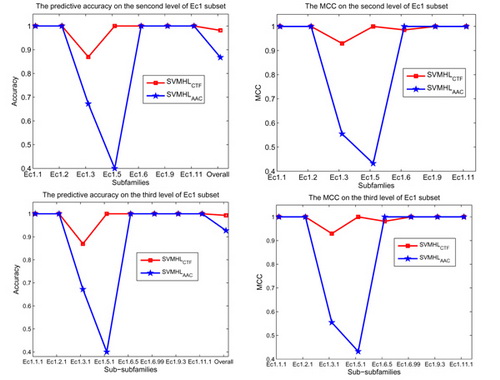Background: Enzymes are known as the largest class of proteins and their functions are usually annotated by the Enzyme Commission (EC), which uses a hierarchy structure, i.e., four numbers separated by periods, to classify the function of enzymes. Automatically categorizing enzyme into the EC hierarchy is crucial to understand its specific molecular mechanism.
Results:In this paper, we introduce two key improvements in predicting enzyme function within the machine learning framework. One is to introduce the efficient sequence encoding methods for representing given proteins. The second one is to develop a structure-based prediction method with low computational complexity. In particular, we propose to use the conjoint triad feature (CTF) to represent the given protein sequences by considering not only the composition of amino acids but also the neighbor relationships in the sequence. Then we develop a support vector machine (SVM)-based method, named as SVMHL (SVM for hierarchy labels), to output enzyme function by fully considering the hierarchical structure of EC. The experimental results show that our SVMHL with the CTF outperforms SVMHL with the amino acid composition (AAC) feature both in predictive accuracy and Matthew’s correlation coefficient (MCC). In addition, SVMHL with the CTF obtains the accuracy and MCC ranging from 81% to 98% and 0.82 to 0.98 when predicting the first three EC digits on a low-homologous enzyme dataset. We further demonstrate that our method outperforms the methods which do not take account of hierarchical relationship among enzyme categories and alternative methods which incorporate prior knowledge about inter-class relationships.
Conclusions:Our structure-based prediction model, SVMHL with the CTF, reduces the computational complexity and outperforms the alternative approaches in enzyme function prediction. Therefore our new method will be a useful tool for enzyme function prediction community.

Figure 1. The comparison of feature encoding methods ACC and CTF.
The predictive accuracy (the left two subfigures) and MCC (the right two subfigures)
on the second and third level of Ec1 subset for SVMHL with the CTF (SVMHLCTF) and SVMHL with the AAC (SVMHLAAC).
Additional Information:
1 Author Information:Yong-Cui Wang1,2, Yong Wang3, Zhi-Xia Yang4*, Nai-Yang Deng1
Correspondence: xjyangzhx@sina.com.
2 Published : 20 June 2011, BMC Systems Biology 2011, 5(Suppl 1):S6.
